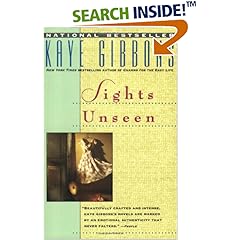 Lots of people wouldn’t enjoy reading a book about a bipolar mother who neglects her children and almost worries her long-suffering husband into his grave. Call me warped, but I really like reading about people who live on the edges (and off the pages completely) of sanity and normality. I think it teaches me something about the boundaries of what we call sane and makes me trust that God is somehow out there beyond those boundaries, too.
Lots of people wouldn’t enjoy reading a book about a bipolar mother who neglects her children and almost worries her long-suffering husband into his grave. Call me warped, but I really like reading about people who live on the edges (and off the pages completely) of sanity and normality. I think it teaches me something about the boundaries of what we call sane and makes me trust that God is somehow out there beyond those boundaries, too.
So Sights Unseen by Kaye Gibbons is that sort of book. It’s also a Southern book, and I like that, too. The mother in her illness is described compassionately, but realistically, even though it is obvious that her illness infllicts emotional damage on every member of her family and that sometimes, often, the young narrator of the novel, Hattie, the daughter, is not sure what to think of her mother or how to deal with her manic depressive episodes.
The novel begins at the end so that the reader knows that the mother eventually gets treatment and is able to to get relief from her symptoms and relate to her daughter and to the rest of her family in a healthy way. Then, the narrator tells how her mother died at the age of sixty-two after many years of bipolar illness and only fifteen years of health. The rest of the novel moves back and forth in time as Hattie recalls her childhood memories of living with her mother’s mental illness. The memories are scattered through time, disorganized, just as Hattie’s mother’s mind is scattered and disorganized under the influence of alternating bouts of mania and depression. This sort of presentation makes more work for the reader than a strictly chronological account would entail; however, it also gives a feeling of
verisimilitude to the story of the memories of a child growing up in a chaotic household.
There is a character who brings some stability to Hattie’s childhood years, Pearl, the black housekeeper, cook, and caretaker for Hattie and her older brother and their mother. The father in the story is much too busy trying to work and take care of his wife; he has very little time or energy for his two children. Amazingly enough, however, this dysfunctional family is also shown to be a loving and strengthening place of nurture for Hattie and her brother who manage to grow up to love themselves, each other and their parents.
The ending of the novel was a bit disconcerting. Ms. Gibbons tells us all about what it is like to live with a mentally ill parent, but very little about what it is like to reconnect with that parent once she is able to function and care for her children somewhat normally. Maybe “normal” doesn’t make much of a story; life in the Land of Mental Illness does include lots of adventure, although it’s the kind of adventure that you’d want to read about rather than live. I would have liked to read more about how the teen-aged Hattie and her mother managed to establish a new relationship based on health rather than sickness.
I give the book a B+, and if you like the subject, you’ll probably enjoy the story of Hattie and her family in Sights Unseen. Oh, by the way, this book has a child/teen narrator, but it’s not a children’s or YA title; some of the subject matter, although not lurid or gratuitous, is for adults.
Sherry,
You absolutely have to read Hugging the Rock by Susan Taylor Brown! Beautifully written in free verse, a young girl has to come to terms with her mother’s mental illness and abandonement. As her relationship with hre father strengthens, the healing begins. *****
I think it must be a good thing to delve into this book with the knowledge that there is treatment and healing, but I would think that it would only make the ending more disappointing. I guess I like happily ever after or at least closure.
Thanks for the review. Very well written.
Pingback: Semicolon